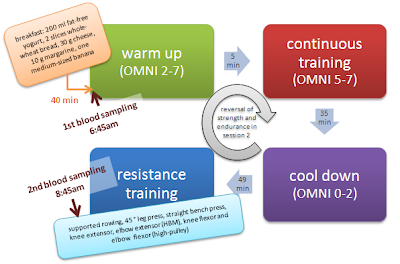Before or after - more than a question of personal preferences?
The subjects of the respective study were 10 randomly selected male volunteers (27.1 ± 4.8 years, 74.89 ± 0.30 kg; 172 ± 0.03 cm; BMI 25.38 ± 0.09)who had engaged in regular physical activity 3 times per week for at least 6 months and thusly represent the "average aspiring gymrat", who often wants a Mr. Olympia or Men's Health cover model physique, but whose schedule allows for no more than max. three training sessions per week.
 |
| Figure 2: Absolute leptin and cortisol levels in control (no exercise), endurance first or strength first sessions before and after the 2h rest / workouts (left); relative changes from pre to post during each of the three sessions (right; data adapted and calculated based on Rosa. 2012) |
The smaller reduction in circulating leptin levels speaks in favor of lifting weights first
If we take a closer look at the relative changes from pre to post within the individual groups (figure 2, right), it does yet become obvious that the "strength first" session produced an overall more favorable hormonal response than its "endurance first" counterpart. After all, the human body interprets a reduction in leptin (at least in the absence of a profound upregulation of leptin sensitivity) as "starvation signal" to which it will respond with adequate reductions in overall calorie expenditure and fatty acid oxidation.
A brief note on cortisol: Whether the concomitantly more pronounced reduction in cortisol is a good, or in view of the increasing number of people with chronically low cortisol levels and "adrenal burnout" or "central fatigue syndrome", is something everybody would probably have to answer for him-/herself as an individual. In view of the fact that both regimen lead to a significant reduction (-26% and -34%), the results of the study at hand would yet underline my general recommendation to refrain from any type of exhaustive exercise when you notice that your adrenal glands cannot cope with whatever stressors they have been exposed to any longer. After all, chronically low cortisol levels impede weight loss and performance just as profoundly as the dreaded opposite extreme - an established fact which is unfortunately commonly overlooked in the cortisol-phobic fitness community.
In this context, it is also worth mentioning that according to a 2003 meta-analysis by Hulver et al. (Hulver. 2003) all the studies investigating "long" (>1h) duration exercise bouts [...] convincingly [...] indicate that serum leptin concentrations are reduced with exercise durations ranging from one to multiple hours [, probably] due to alterations in nutrient availability or nutrient flux at the level of the adipocytes.This, in turn, would support the earlier voiced objection that doing weight and cardio on separate days would be the optimal, yet for many trainees simply impracticable option. So, in case you are part of this group of trainees, it appears prudent to schedule your "cardio" sessions right after your strength workouts. And if you also replace the arduous light-to-medium intensity steady state exercise by a very brief (!) high intensity interval session (HIIT; 4-6 intervals, 10-15min max), you can well be in and out of the gym in <1h and could thusly get away without any significant reductions in leptin.

